
Scientists from Chinese institutions have identified a root development gene that can be removed to make irrigated rice varieties more tolerant to the drought.
The discovery, published in April in the scientific journal Molecular Plantcan contribute to the reduction of water use in rice production, a culture that is responsible for much of agricultural water consumption, especially in China.
The study was conducted by researchers from BGI-research, Huazhong Agricultural University in Wuhan, and Yunnan University.
The team analyzed 16 rice cultivars – eight high and eight irrigated lands – focusing on root morphological differences. The goal was to understand how tall lands rice, which grows in dry environments, develops deeper and thick root systems, characteristics directly linked to drought resistance.
Among the 376 genes associated with the development of the roots identified in the study, a transcript regulator called Hmgb1 It was highlighted as a factor that limits root growth in irrigated cultivars. According to the researchers, the removal of the HMGB1 gene allowed the irrigated rice to develop longer and more robust roots, giving it greater tolerance for water scarcity.
“The rice of high land is a special rice ecotype that specifically adapts to arid lands, mainly due to its robust root system,” the authors said in the article. “Among the identified genes, HMGB1, a transcript regulator, acts as a key factor that facilitates the stretching and thickening of the roots in the rice of high land, thus increasing drought resistance.”
According to the study, the expression level of the HMGB1 gene is inversely related to drought tolerance. “We found that the drought resistance rate and the root length of high land rice varieties have decreased by increasing HMGB1 expression level,” the researchers wrote.
The research also presents transcriptomic data that reveals how the roots of rice of highlands express genes spatially differently, contributing to their adaptation to rainfall conditions. The authors say that this information represents a relevant genetic resource for the development of more resilient cultivars of climate change.
In the team’s assessment, findings can be applied to cross -land cross programs and irrigated rice, with the aim of generating varieties that unite the productivity of irrigated cultivars with drought resistance of rainfed ecotypes.
Zhong Liyuan, an associate researcher at BGI-research and the first author of the article, said the process for creating a stable variety can take between eight and ten years.
“Selecting desired hybrid descendants from the cross of rice of high and irrigated land, and stabilizing the characteristics over time,” is the proposed method, Zhong explained.
The researcher added that the identification of key genes allows to reduce the time needed for improvement compared to conventional techniques.
“We can make a targeted selection instead of undergoing a completely random process. The longer step will be to stabilize these characteristics, as several generations need to be planted to ensure consistency.”
Irrigated rice represents 55% of rice cultivation areas worldwide and accounts for 75% of global culture production.
In China, this method concentrates 70% of agricultural water use and half of all national water demand. The country is the largest rice producer in Asia, responsible for about a quarter of the regional offer.
With the intensification of the effects of climate change, prolonged drought events have become more frequent, pressing agricultural systems that depend strongly on irrigation. In this context, researchers and institutions from various countries have sought solutions to develop more efficient water use crops.
Chinese study proposes a genetic approach to facing the vulnerability of irrigated rice in the face of water scarcity. By using highland genetic information, research aims to provide a scientific basis for the development of hybrid varieties more adaptable to adverse climate scenarios.
The team aims to continue the large -scale tests and crosses to consolidate the observed laboratory and field results. It is expected that, in the coming decades, irrigated rice cultivation may be less dependent on intensive irrigation and more aligned with sustainable water use practices.
Source: https://www.ocafezinho.com/2025/05/07/pesquisadores-chineses-identificam-gene-que-limita-resistencia-a-seca-em-arroz/

